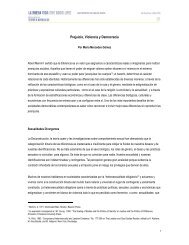Speaking Democracy: Carlos Motta's The Good Life - La buena vida
Speaking Democracy: Carlos Motta's The Good Life - La buena vida
Speaking Democracy: Carlos Motta's The Good Life - La buena vida
You also want an ePaper? Increase the reach of your titles
YUMPU automatically turns print PDFs into web optimized ePapers that Google loves.
public archive of opinions on these subjects. Hailing from Bogotá, Colombia, Motta was interested in how U.S.<br />
interventionism was perceived across the continent, as well as in understanding the role of these events on his own<br />
perceptions of what it means to be a citizen, an acting subject in society. Basing his itinerary on cities that had been<br />
influenced by specific historical circumstances (sites of failed revolutions, military coups, and economic reforms),<br />
Motta, together with local assistants, sought out a range of individuals to speak with in each city. His dialogues with<br />
students, teachers, activists, laborers, etc. resulted in a spectrum of opinion which fluctuated according to local<br />
situations and forms of government. In Santiago, many responses touched on the overthrow of former Chilean<br />
president Salvador Allende in a military coup; in Buenos Aires, the recent economic impositions of the International<br />
Monetary Fund were a source of discussion. <strong>The</strong> dialogues explore the political and social landscapes of each city and<br />
the interview subjects’ lives, unearthing personal narratives and revealing a breadth of collective memory. Each<br />
dialogue take place outdoors, in parks, plazas or sidewalks, transforming public space into a space of action through<br />
public disclosure.<br />
In a gallery-based installation at the Institute of Contemporary Art in Philadelphia in early 2008, viewers encountered<br />
these interviews as a nine-channel video installation. Monitors were mounted on a four-part, two-tiered wooden<br />
structure that was an abstracted reference to the Priene, the theater and general space of the Athenian agora, in which<br />
citizens not only bought and sold goods, but met, debated, and participated in legislative and judicial decisions. <strong>The</strong><br />
position of the monitors on the structure allowed them to metaphorically function as speaking subjects—citizens—in<br />
the space, addressing their comments to a wider forum. In a further evocation of Arendt’s space of public disclosure<br />
(and her theorization of the vita activa, or “active life,” which became increasingly important to Motta over the course of<br />
the project) the structure also created a space for viewers to sit, physically placing them among the previously<br />
recorded speaking subjects.<br />
<strong>The</strong> walls surrounding the structure featured an installation of over 500 video stills, printed as 5 by 7 inch snapshots.<br />
Images were grouped together geographically and chronologically; as in the videos, they were unlabeled (although an<br />
image of that country’s flag preceded each grouping). <strong>The</strong>matically arranged, the stills examined select aspects of life<br />
and visual culture in each city; the path of a religious penitent, public stations of the cross for Catholic parades,<br />
graffitied political statements, and monuments to failed revolutions. As photographs, these images functioned as<br />
indexical traces of physical events created by interventionist policies and their aftermath, and symbolically surrounding<br />
the “speaking space” of the structure. Placed throughout the space was a newsprint publication, in which artists Ashley<br />
Hunt, Naeem Mohaiemen, and Oliver Ressler, and political theorist Maria Mercedes Gomez presented short essays in<br />
response to the question “What is democracy to you?” from different perspectives and using different approaches. Both<br />
the use of the video medium and the inclusion of this “newspaper” referred to mass media, which now is now closely<br />
associated with the idea of public speech in Western society.<br />
2




